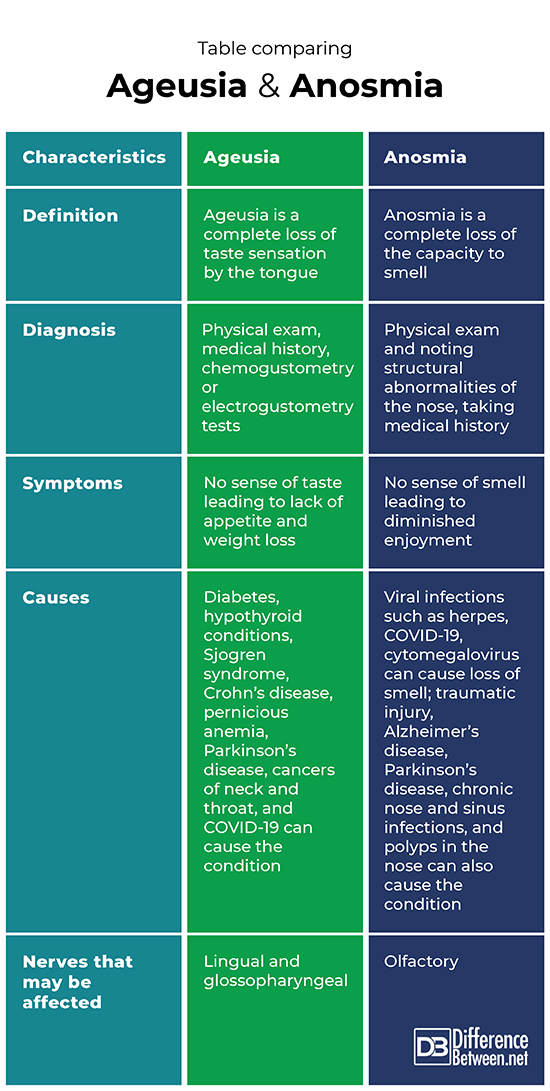Difference Between Ageusia and Anosmia
Ageusia is the complete loss of taste sensation. Anosmia is a total loss of the ability to smell.

What is Ageusia?
Definition:
Ageusia is the total loss of the ability to taste with the tongue. Taste is due to gustatory receptors on the tongue which synapse with various nerves that transmit the sensation to the brain.
Symptoms:
The individual with ageusia is unable to taste food and thus tends to eat less and lose weight. The condition needs to be distinguished from a simple reduced ability to taste food, which is called hypogeusia. The symptoms of the hypogeusia would not be as extreme and there would be some ability to taste while ageusia would be a complete absence of taste ability.
Diagnosis:
A physical exam is done and patient history taken. In addition, various tests including electrogustometry or chemogustometry can be performed in which taste is evaluated.
Causes and complications:
There are several causes of ageusia including damage to two of the cranial nerves, namely the glossopharyngeal and lingual nerves. Diabetes, hypothyroid conditions, Sjogren syndrome, Parkinson’s disease, and even Crohn’s disease or pernicious anemia can all lead to loss of the ability to taste. Besides these causes, cancer in the head and neck region and traumatic injuries can also lead to ageusia. There is also some evidence that ageusia could be due to COVID-19 in some cases. The condition is harmful in that is causes discomfort and a lack of enjoyment of eating, and can lead to anorexia, extreme weight loss and deficiency of nutrients.
Treatment:
Treatment depends directly on the cause of the ageusia with no treatment options for nerve damage available; where the cause is an underlying illness, taste may return once the illness is managed.

What is Anosmia?
Definition:
Anosmia is total loss of any ability to smell. Smell is possible because of olfactory receptors which detect chemicals in the nose and then transmits signals along olfactory nerves to the brain.
Symptoms:
The symptoms of anosmia present as a total inability to smell, and it can be easily confused with ageusia because smell is part of our ability to taste food, so a person may appear to have loss of taste but it could be that they have anosmia instead. Similarly to ageusia, the anosmia is a complete absence of the functioning of the particular sense, and needs to be differentiated from hyposmia which is a decreased ability to smell.
Diagnosis:
Diagnosis is based on the patient’s medical history along with a physical exam in which the nasal passages are examined for potential obstructions.
Causes and complications:
Anosmia can be caused by certain viruses that infect and inflame the central nervous system, for instance, cytomegalovirus, herpes zoster, and herpes simplex. Additional causes of anosmia include allergies and nasal polyps that obstruct the nasal passages, as well as chronic sinusitis and chronic rhinitis. There is some evidence that anosmia could also be caused by the COVID-19 virus in some cases; Alzheimer’s disease and Parkinson’s disease can also lead to loss of smell. Traumatic injury to the nose leading to olfactory nerve damage can also result in anosmia.
Treatment:
Treatment depends on the cause of the anosmia and in some cases the condition may be permanent even after treating the underlying illness causing the problem.
Difference between Ageusia and Anosmia?
Definition
Ageusia is a complete loss of taste sensation and ability by the tongue. Anosmia is a total and complete loss of the ability to smell with the nose.
Diagnosis
A physical exam, medical history, chemogustometry or electrogustometry tests are performed in order to diagnose ageusia in a patient. A physical exam, medical history and examination for nasal obstructions help to diagnose anosmia.
Symptoms
The symptoms of ageusia include having no sense of taste, often resulting in a lack of appetite and thus, weight loss. The symptoms of anomia include having no sense of smell and thus not enjoying life as much as before.
Causes
Diabetes, hypothyroid conditions, Sjogren syndrome, Crohn’s disease, Parkinson’s disease, pernicious anemia, cancers of the neck and throat, and COVID-19 can all cause ageusia. Viral infections such as herpes, cytomegalovirus, and COVID-19 can result in loss of smell; traumatic injury Alzheimer’s disease, Parkinson’s disease, chronic nose and sinus infections, and polyps in the nose can all be causes of anosmia.
Nerves that may be affected
In the case of ageusia, the lingual and glossopharyngeal nerves may be impacted, affecting the transmission of the gustatory impulses to the brain. In the case of anosmia, the olfactory nerves may be impacted causing a problem with the transmission of the olfactory impulses to the brain.
Table comparing Ageusia and Anosmia

Summary of Ageusia Vs. Anosmia
- Ageusia and anosmia are both disorders affecting the senses of the body.
- Both ageusia and anosmia can result from a traumatic injury and can in certain cases be a permanent condition.
- Ageusia is relatively rare but can occur with a range of illnesses including diabetes, Crohn’s disease, and hypothyroidism.
- Anosmia can be a consequence of a viral infection that affects the brain or can be due to structural anomalies of the nose.
- COVID-19 is thought to potentially cause both ageusia and anosmia in some patients who are infected and ill.
- Difference Between Rumination and Regurgitation - June 13, 2024
- Difference Between Pyelectasis and Hydronephrosis - June 4, 2024
- Difference Between Cellulitis and Erysipelas - June 1, 2024
Search DifferenceBetween.net :
Leave a Response
References :
[0]Fried, Marvin P. “Anosmia”. Merckmanuals. Merck & Co., 2020, https://www.merckmanuals.com/en-pr/professional/ear,-nose,-and-throat-disorders/approach-to-the-patient-with-nasal-and-pharyngeal-symptoms/anosmia
[1]Tarakad, Arjun, and Joseph Jankovic. "Anosmia and ageusia in parkinson's disease." International Review of Neurobiology. Vol. 133. Academic Press, 2017. 541-556.
[2]Zusho, Hiroyuki. "Posttraumatic anosmia." Archives of Otolaryngology 108.2 (1982): 90-92.
[3]Image credit: https://commons.wikimedia.org/wiki/File:Anosmia.jpg
[4]Image credit: https://live.staticflickr.com/974/42062624102_525057e688_b.jpg
